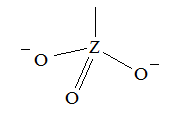The following electronic configuration and drawing of the structure are given:
$\mathrm{(1s)^2 (2s)^2 (2p)^6 (3s)^2 (3p)^6 (3d)^{10} (4s)^2 (4p)^4}$
How does this image correspond with the electronic configuration?
My train of thoughts so far:
Since the configuration has 34 electrons, I assume the element Z is actually selenium (atomic number 34). It could also be gallium since Z has no charge and has five covalent bonds to look like krypton. This is mere speculation since I just don't know how to approach the problem.
I am unsure what kind of bonds are present here. The tetrahedral form, even though it consists of a total of five bonds, indicates hybridization, but I am completely unfamiliar with hybridization outside of carbon-like hydbridization (four bonds). I am guessing one double bond leads to sp$^2$ hybridization.

